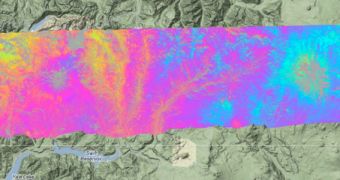Officials at the NASA Jet Propulsion Laboratory (JPL), in Pasadena, California, announce that one of the instruments the organization developed, a special type of 3D aerial laser, has recently taken off aboard a NASA aircraft, and is currently heading to Alaska and Japan, for a study of active volcanoes.
Scientists plan to conduct the study over the next 10 days. The most important instrument is the Uninhabited Aerial Vehicle Synthetic Aperture Radar (UAVSAR), which is installed in a special pod, under the fuselage of a modified C-20A (G-III) aircraft operated by NASA.
The airplane left the agency's Dryden Aircraft Operations Facility, in Palmdale, California, on October 2, headed for the Joint Base Lewis-McChord, in Tacoma, Washington. Its next stop will be the Joint Base Elmendorf-Richardson, near Anchorage, Alaska.
The UAVSAR is capable of identifying very subtle deformations under the surface, enabling scientists to figure out when more magma is gathering under a volcano. In turn, this can help refine predictions as to when a future eruption might occur.

 14 DAY TRIAL //
14 DAY TRIAL //